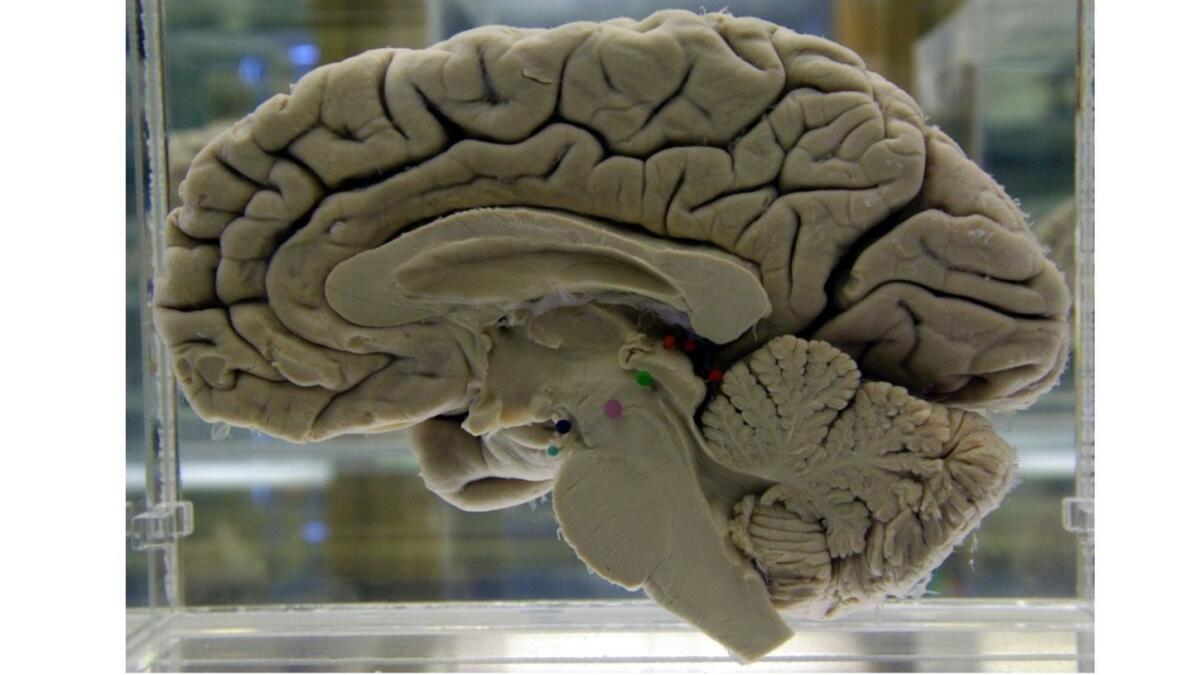Brainstorming the ethics of neuroscience research in the age of organoids
- Share via
Could a clump of interlocking brain cells in a Petri dish ever experience self-awareness? Can you make a mouse or a monkey partly human by implanting human stem cells in its brain? If pieces of a dead person’s brain are reanimated in a lab, is the patient still completely dead?
Questions like these are being raised by advancing techniques at the cutting edge of neuroscience. Far-fetched though they may seem, they are forcing scientists to wrap their heads around what it takes to be a human brain.
Neuroscientists may not yet be creating conscious mini-brains in their labs. But that prospect, while distant, is real. And as things stand now, scientists may not truly recognize when they have crossed that indistinct boundary.
So it’s not too early to ponder scenarios that seem to have more in common with sci-fi thrillers than real life, according to a group of 17 neuroscientists and medical ethicists who made their case this week in an essay published in the journal Nature.
In labs across the world, scientists have used stem cells to grow multicellular structures that resemble human organs, including the eye, gut, liver and kidney. Now the same techniques are being used to grow brain “organoids” — miniaturized, simplified versions of living brain tissue.
Brain scientists are transplanting these organoids, or the human stem cells from which they are grown, into other animals. Elsewhere, they are probing the function of brain tissue excised from people who have just died, or from patients who have had brain tissue removed to treat diseases such as epilepsy.
The knowledge gleaned from this research will help brain scientists understand at a very basic level how this complex organ develops, how its components work individually and together, and what goes wrong in certain psychiatric and neurological disorders.
Those diseases are a universal cause of suffering. So abandoning this research would arguably be unethical, the authors of the new essay wrote. But going forward has its ethical perils too.
“To ensure the success and social acceptance of this research long term, an ethical framework must be forged now,” wrote the experts, who met last May at Duke University’s Initiative for Science and Society to hammer out a list of concerns.
Most of these brain organoids live in growth medium in a lab dish and lack the blood supply and specialized cells needed for basic housekeeping functions. They consist of somewhere between 2 million and 3 million cells (a mature human brain has about 170 billion) and are no bigger than, say, an adult fruit fly.
Yet these organoids are tiny facsimiles of part of a human brain. Already, they are being grown and fused into “assemblages” of brain structures. It is hardly beyond imagining that one day researchers could create a miniaturized model of the exquisitely complex organ that can create, store and retrieve memories; love and hate other creatures; and contemplate its own place in the universe.

Scientists have already transplanted human brain organoids into rodents. In short order, the cluster of human brain cells lashed themselves to their hosts’ neurons, and the rodents’ neurons appeared to return the embrace. Indeed, the researchers discerned evidence of crosstalk between the human organoid and the rodent brain that had become its host, according to a study published this month in Nature Biotechnology.
In related work, neuroscientists already have used human stem cells to grow glial cells (a type of brain cell involved in cerebral housekeeping) and transplanted them into the brains of mice. In certain learning tasks, the hybrid mice performed better than their counterparts that were 100% mouse.
Meanwhile, researchers at the Yale School of Medicine (among them neuroscientist and essay coauthor Dr. Nenad Sestan) have reportedly restored circulation to the brains of decapitated pigs and kept the reanimated organs ”alive” for up to 36 hours. Though the pig brains showed no signs of consciousness, the experiment suggested that, with sufficient tending, brain cells might be capable of normal activity after their host’s death.
And at Harvard, stem cell biologist Paola Arlotta (also one of the essay’s authors) grew 31 human brain organoids over periods as long as nine months and watched as pluripotent stem cells gave rise to human retinal cells alongside other brain cells. When her team shined a light on the retinal cells growing in a lab dish, they effectively saw the brain cells “blink” in response — evidence that “an external stimulus can result in an organoid response,” the team reported last year in Nature.
Add time, academic ambition and scientific progress to these instances and you begin to appreciate the questions raised in the essay:
Should brain organoids, or non-human creatures bearing human brain cells, be protected by regulations that acknowledge the possibility of their greater awareness?
Should that possibility preclude the creation of chimeras that involve our close evolutionary relatives, such as chimps or monkeys?
Who owns the organoids or animals created by these processes, and what say should the human owners of stem cells or brain tissue have in their subsequent use? Should there be limits on the ability of human tissues to “live” outside of their original owner?
“There are so many issues we need to think about,” said Henry T. Greely, who drafted the essay along with Duke bioethicist Nita Farahany.
One other bit of outstanding business: how to define consciousness, an attribute that would certainly justify stronger protections for the organoids and other organisms believed to have it.
”The signals for consciousness or unconsciousness detected in a living adult — using electroencephalography (EEG) electrodes, for example — don’t necessarily translate to infants, animals or experimental brain surrogates,” the group wrote. “Without knowing more about what consciousness is and what building blocks it requires, it might be hard to know what signals to look for in an experimental brain model.”
Greely, a lawyer who directs Stanford University’s Program in Neurosciences and Society, said the thorniest ethical problems are not immediate. “But I do think in five to 10 years, there’s a really good chance we’ll have to ask, ‘Are we there yet?’”
The best evidence that the time has come to discuss these matters is the active engagement of scientists at the front lines of such work, Greely said. Usually, “it’s a reflex” to resist discussions that might place strictures on their work.
“They’re all convinced that these ethical concerns are really important,” Greely said. “That, to me, is a pretty powerful signal.”
Twitter: @LATMelissaHealy
MORE IN SCIENCE
Here’s why the apparent increase in autism spectrum disorders may be good for U.S. children
Scientists have a promising new approach for treating drug-resistant tuberculosis
In human cells, scientists find DNA that looks like a twisted knot instead of a double helix







